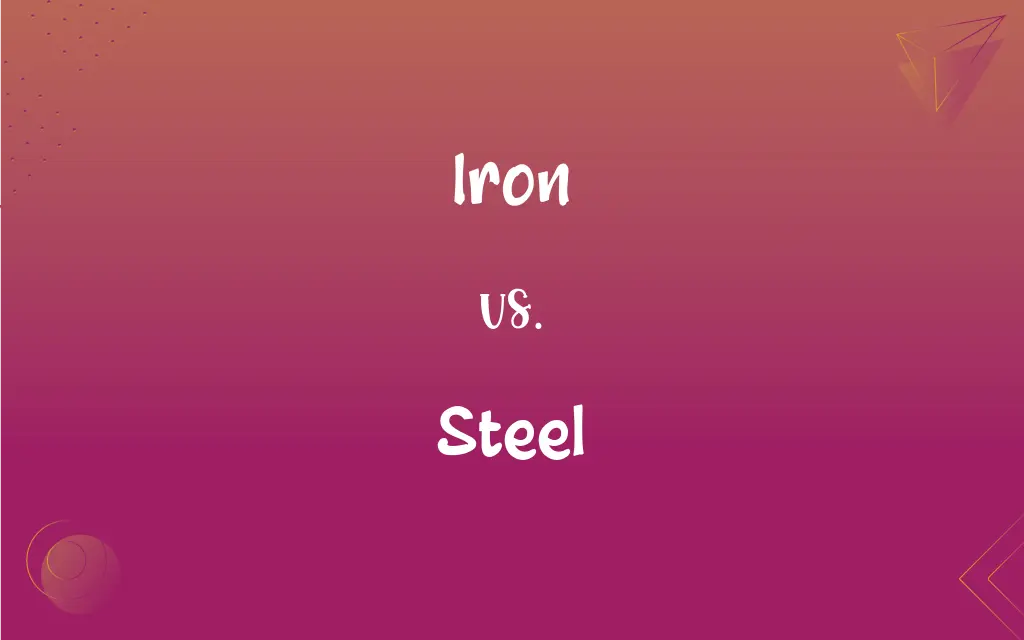Iron vs. Steel: What's the Difference?
Edited by Aimie Carlson || By Harlon Moss || Updated on June 6, 2024
Iron is a chemical element (Fe), while steel is an alloy mainly composed of iron with a small amount of carbon and sometimes other elements, providing increased strength and resistance to wear.

Key Differences
Iron, denoted chemically by “Fe”, stands as a primary elemental metal, inherently malleable yet robust. The substance has facilitated numerous industrial epochs, symbolizing its utilization in various tools, machinery, and construction applications. Meanwhile, steel manifests as an alloy, particularly a concoction comprising primarily of iron, underscored by a characteristically minimized carbon content, generally around 0.2% to 2.1%.
Steel showcases a realm dominated by the palpable characteristics of enhanced strength and durability, amidst other tailored attributes. Subsequently, these variations stem from the controlled proportionality of carbon and at times, other alloying elements. Simultaneously, iron, in its elemental state, projects a relatively softer, more ductile nature, albeit embodying a quintessential role in steel's formulation, bridging the transitional attributes between both materials.
Iron exhibits intrinsic properties like magnetism and is fundamentally employed in its unalloyed form or as a constituent in various alloys like steel. Its historical prevalence underpins civilizations, portraying a vivid display of evolution in usage and alloy development. Contrastingly, steel, derived and forged from the elemental prowess of iron, exists consequentially from the quest to harness enhanced material attributes like superior tensile strength and resistance to wear and corrosion.
A metaphoric discourse likens iron to a foundational base, a pivotal entity around which metallurgical advancements swirl. Here, iron’s omnipresence in diverse applications, from home appliances to large-scale structures, is vividly apparent. Steel, conversely, emerges as a character meticulously crafted from iron, embracing technological advancements to meet a spectrum of engineering and architectural demands, thereby widening its applicative horizon compared to iron.
In essence, iron and steel coexist in a harmonious dichotomy, entwining their existences through a rich tapestry of human innovation and development. Iron, reminiscent of a primordial era, whispers tales of raw, fundamental utility. In juxtaposition, steel narrates a saga wherein iron is transcended, amalgamating with carbon and other elements, to forge an entity capable of withstanding the rigors of modern applications and intricate designs.
ADVERTISEMENT
Comparison Chart
Composition
Pure element (Fe)
Alloy, primarily of iron and carbon
Carbon Content
Does not contain carbon intentionally
Contains carbon (0.2% to 2.1%)
Hardness
Generally softer and more ductile
Harder and stronger due to carbon content
Magnetism
Naturally magnetic
May or may not be magnetic based on its type
Usage
Used in pure form or in alloys
Extensively used in construction and machinery
ADVERTISEMENT
Iron and Steel Definitions
Iron
It’s a ductile, malleable, silver-gray metal extensively used in construction and manufacturing.
The Eiffel Tower was constructed using iron due to its stability and strength.
Steel
It’s a versatile material used in various industries due to its adjustable properties.
The automobile industry frequently uses steel for its durability and strength.
Iron
Iron is a chemical element symbolized as Fe and possesses atomic number 26.
The element iron is crucial for transporting oxygen in human blood.
Steel
It's utilized widely in construction due to its exceptional tensile strength and reliability.
The use of steel in residential buildings has increased due to its fire-resistant properties.
Iron
Iron, in its varied forms, finds applications in a multitude of industrial sectors.
The iron ore is smelted in blast furnaces to extract the metal for use in various industries.
Steel
Steel is an alloy combining iron and carbon, often with other elements, to enhance strength and other properties.
Skyscrapers utilize steel beams to withstand tremendous weights and winds.
Iron
Iron serves as a primary ingredient in the formulation of various alloys.
Iron is alloyed with carbon to produce the much stronger material, steel.
Steel
Steel often undergoes various processes like tempering and annealing to augment its characteristics.
The sword was made from tempered steel to ensure sharpness and durability.
Iron
It is an essential nutrient in living organisms, ensuring the proper functioning of hemoglobin.
Spinach is often recommended to boost iron levels in the body.
Steel
Steel signifies a category of materials which can be tailored to possess specific, desirable properties.
The bridge was constructed with a specific type of steel to prevent corrosion from the saltwater.
Iron
Symbol Fe A silvery-white, lustrous, malleable, ductile, magnetic or magnetizable, metallic element occurring abundantly in combined forms, notably in hematite, limonite, magnetite, and taconite, and used alloyed in a wide range of important structural materials. Atomic number 26; atomic weight 55.845; melting point 1,538°C; boiling point 2,861°C; specific gravity 7.874 (at 20°C); valence 2, 3, 4, 6. See Periodic Table.
Steel
A generally hard, strong, durable, malleable alloy of iron and carbon, usually containing between 0.2 and 1.5 percent carbon, often with other constituents such as manganese, chromium, nickel, molybdenum, copper, tungsten, cobalt, or silicon, depending on the desired alloy properties, and widely used as a structural material.
Iron
An implement made of iron alloy or similar metal, especially a bar heated for use in branding, curling hair, or cauterizing.
Iron
Great hardness or strength; firmness
A will of iron.
FAQs
What industries heavily utilize steel?
Construction, automotive, and manufacturing industries predominantly use steel.
What is iron?
Iron is a chemical element, symbolized as Fe, and is malleable and ductile.
What defines steel?
Steel is an alloy, primarily made of iron and carbon, known for its strength.
How is iron extracted?
Iron is typically extracted from iron ore using a blast furnace.
Can iron rust?
Yes, iron can oxidize to form rust when exposed to moisture and oxygen.
How is steel produced from iron?
Steel is produced from iron by adding carbon and undergoing a series of processes in a steel mill.
Is steel resistant to corrosion?
Steel can resist corrosion, especially stainless steel which contains chromium.
Why is steel preferred in skyscraper construction?
Steel is preferred due to its high strength, durability, and ability to withstand various stresses.
What types of steel are commonly used?
Common types include stainless steel, carbon steel, and alloy steel, each with different applications.
Can steel's properties be altered?
Yes, altering carbon content and conducting heat treatments can modify steel’s properties.
Are iron and steel magnetic?
Iron is naturally magnetic, while steel's magnetism can depend on its specific type and composition.
Why is iron important for humans?
Iron is vital for humans as it helps in oxygen transportation through hemoglobin.
How is iron used in our day-to-day life?
Iron is used in various appliances, vehicles, and infrastructures in our daily life.
What is cast iron?
Cast iron is an iron-carbon alloy with carbon content higher than 2%, known for its castability and durability.
Why is iron magnetic?
Iron’s atoms have magnetic moments that align to generate a net magnetic field.
What are the environmental impacts of iron mining?
Iron mining can lead to landscape alteration, pollution, and habitat disruption.
How does steel’s alloying elements affect its properties?
Alloying elements can enhance steel’s hardness, corrosion resistance, and tensile strength.
How is steel’s strength determined?
Steel’s strength is often determined by its carbon content and the presence of other alloying elements.
Can steel be recycled?
Yes, steel can be recycled without degrading its quality.
Which is harder, iron or steel?
Steel is generally harder and stronger than iron due to its carbon content.
About Author
Written by
Harlon MossHarlon is a seasoned quality moderator and accomplished content writer for Difference Wiki. An alumnus of the prestigious University of California, he earned his degree in Computer Science. Leveraging his academic background, Harlon brings a meticulous and informed perspective to his work, ensuring content accuracy and excellence.
Edited by
Aimie CarlsonAimie Carlson, holding a master's degree in English literature, is a fervent English language enthusiast. She lends her writing talents to Difference Wiki, a prominent website that specializes in comparisons, offering readers insightful analyses that both captivate and inform.































































